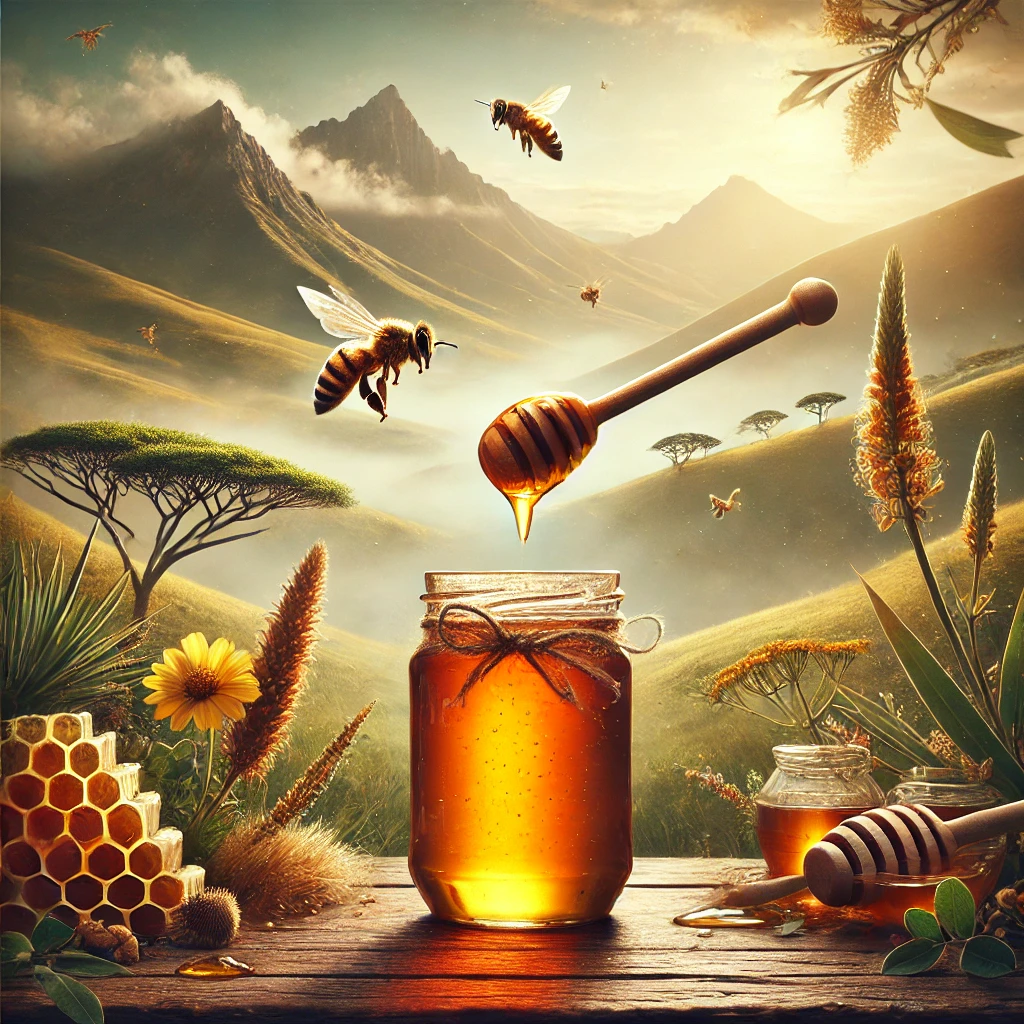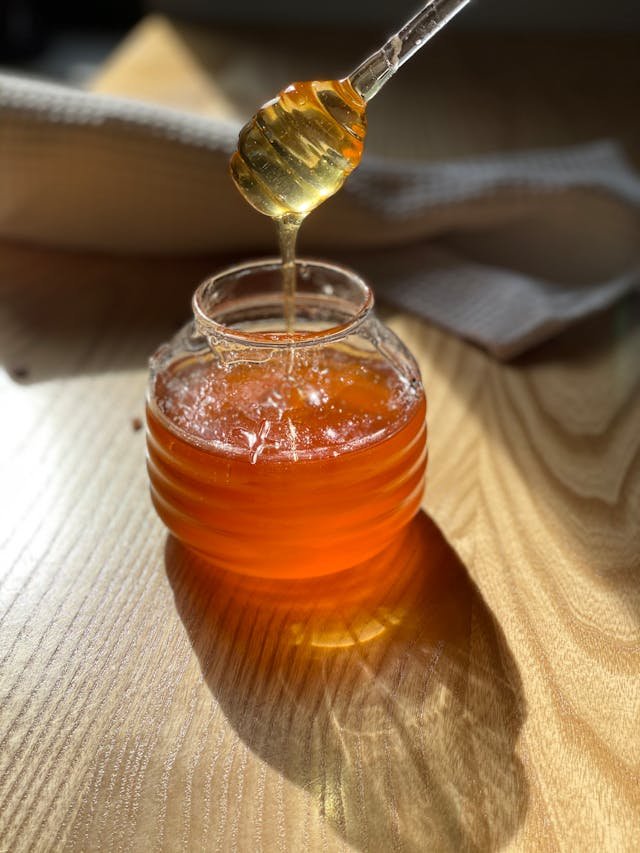Born from the blossoms of evergreen forests deep in the heart of Africa’s high-altitude regions, it’s harvested sustainably from the slopes of Ethiopia’s Highlands and Kilimanjaro, it’s brimming with antioxidants and nutrients. Learn about its medicinal properties, distinctive taste, traditional hive styles used in beekeeping, and its importance as a cash crop in countries throughout Africa. It’s ideally suited for skin care, cuisine, and wellness!
Formation of Mountain Honey

Overview of Mountain Honey
Mountain honey comes from bees living at a high altitude area. It was extracted from wild plants in the mountains. This honey contains beneficial nutrients such as antioxidants and vitamins. It is also a very strong, rich flavor due to the unique plants that are used for the bees to collect their nectar from.
Mountain honey has been used for a long time to enhance health. It aids digestion, boosts the immune system and heals wounds. Due to its natural properties it is very common for both edible marination and skin care.
What it’s specific to Africa
In Africa, mountain honey has a significant different flavor due to the vast amount of plants that grow in the mountains. The unique plants in areas like the Ethiopian Highlands, Mount Kilimanjaro, and Rwenzori Mountains are responsible for the honey’s flavour and health properties. The fresh air and clean atmosphere make it pure and nutritious.
Traditional methods are often employed to harvest honey in Africa. Some mountain bee species, such as the African honey bee, are adapted to mountain conditions. These bees also pollinate plants, helping to keep the ecosystem thriving. This rarity increases the value of African mountain honey.
Environmental and Ecological Factors
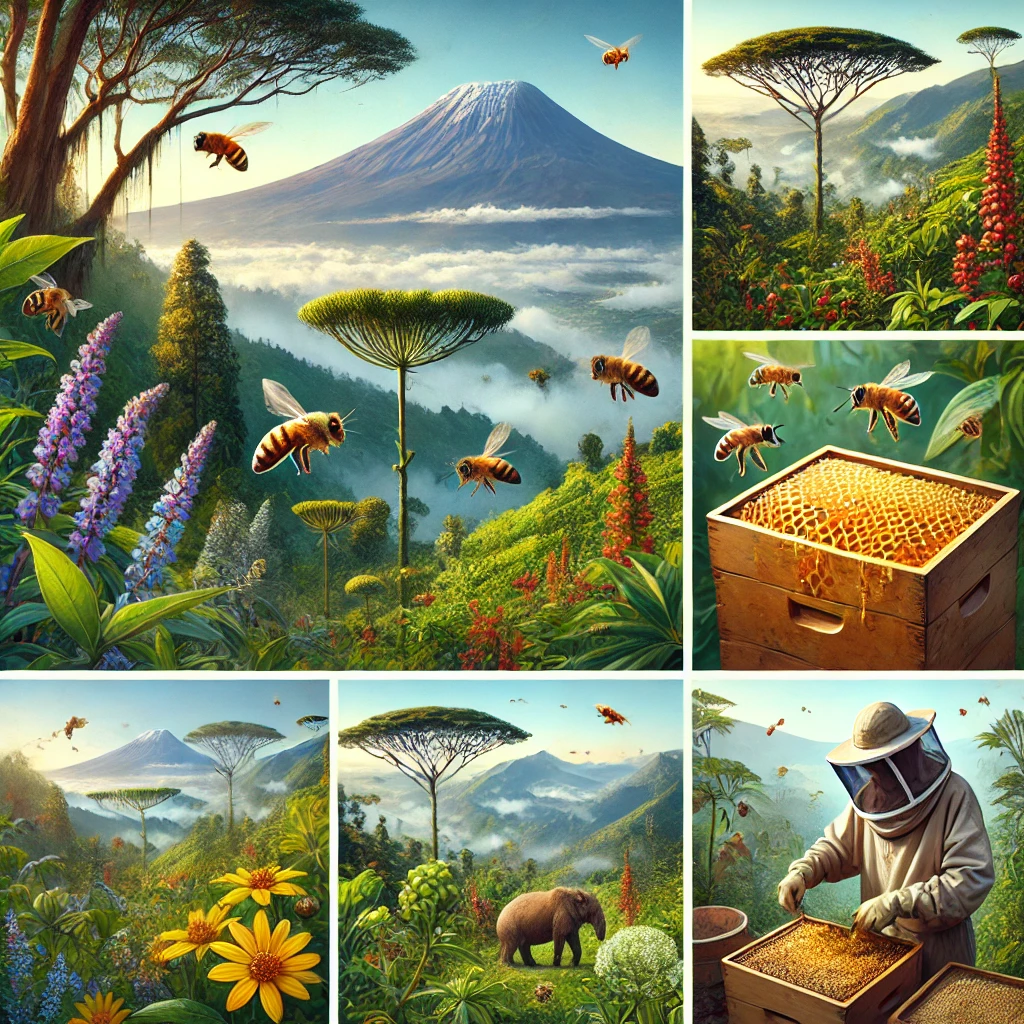
Here in Africa, mountain honey reflects the characteristics of the ecosystems that surround it. The climate, the plants and the high altitude all contribute to the uniqueness of this honey. Here, we look at some of the major honey-producing mountain regions of Africa and how the environment contributes to honey characteristics.
Beekeeping in African Mountain Areas famous for honey
Ethiopian Highlands
The Ethiopian Highlands are known for their biodiversity. Bees in this area forage on Eucalyptus and wild herbs that give the honey a full, aromatic flavor. Bee culture serves as an important part of income generation for many rural communities. Ethiopia a honey producer in Africa.
Typically, bees are raised in vertical chambers with access to entry holes, as shown in the photo above. Food and Agriculture Organization (FAO).
Rwenzori Mountains (Uganda and the Democratic Republic of the Congo)
The Rwenzori Mountains, known as the “Mountains of the Moon,” boasts a cooler and mistier climate. The varied plant ecosystem features tropical alpine vegetation which has a unique floral profile and in turn gives an exclusive signature to the honey. Honey from this area is usually dark and nutrient-rich.
For reference; Nsubuga, F. W. “The Impact of Mountain Biodiversity on Beekeeping in Rwenzori” African Journal of Ecology. 2021.
Mount Kilimanjaro (Tanzania)
Mount Kilimanjaro is surrounded by forests containing a patchwork of tropic and highland vegetation. The bees here collect nectar from coffee plants, wildflowers and acacia trees, which lends the honey a sweet, nuanced flavor. Honey from this region is prized locally and abroad.
Reference: Mwakatobe, A. Tanzania Agricultural Research Institute, 2019.
Effect of Climate, Flora and Altitude on Quality of Honey
African mountain region environments have been shown to affect honey both nutritionally and in flavor:
Climate
The honey is preserved in its natural form due to the cooler temperatures and lower pollution found in mountain ranges. Honey from cooler climates also tends to provide higher levels of antioxidants and health benefits.
Flora (Plants)
Nectar collected by bees from different types of plants will influence the taste, color, and aroma of the resulting honey. For example, wildflowers and medicinal herbs can add a deep, earthy flavor to the honey. These factors create unique plant combinations in each mountain region, giving its honey a distinctive taste.
Altitude
Being at high altitudes minimizes pest and disease pressure allowing bees to thrive without chemicals. And this makes honey from the honeycomb that is natural organic honey rich in minerals. Also, at higher elevations, bees generally make denser, more nutritious honey.
Reprint from: Crane, E. “The Relationship Between Altitude and Honey Composition. International Bee Research Association, 2018.
Bee–keeping and Honey Making process of Mountain Honey
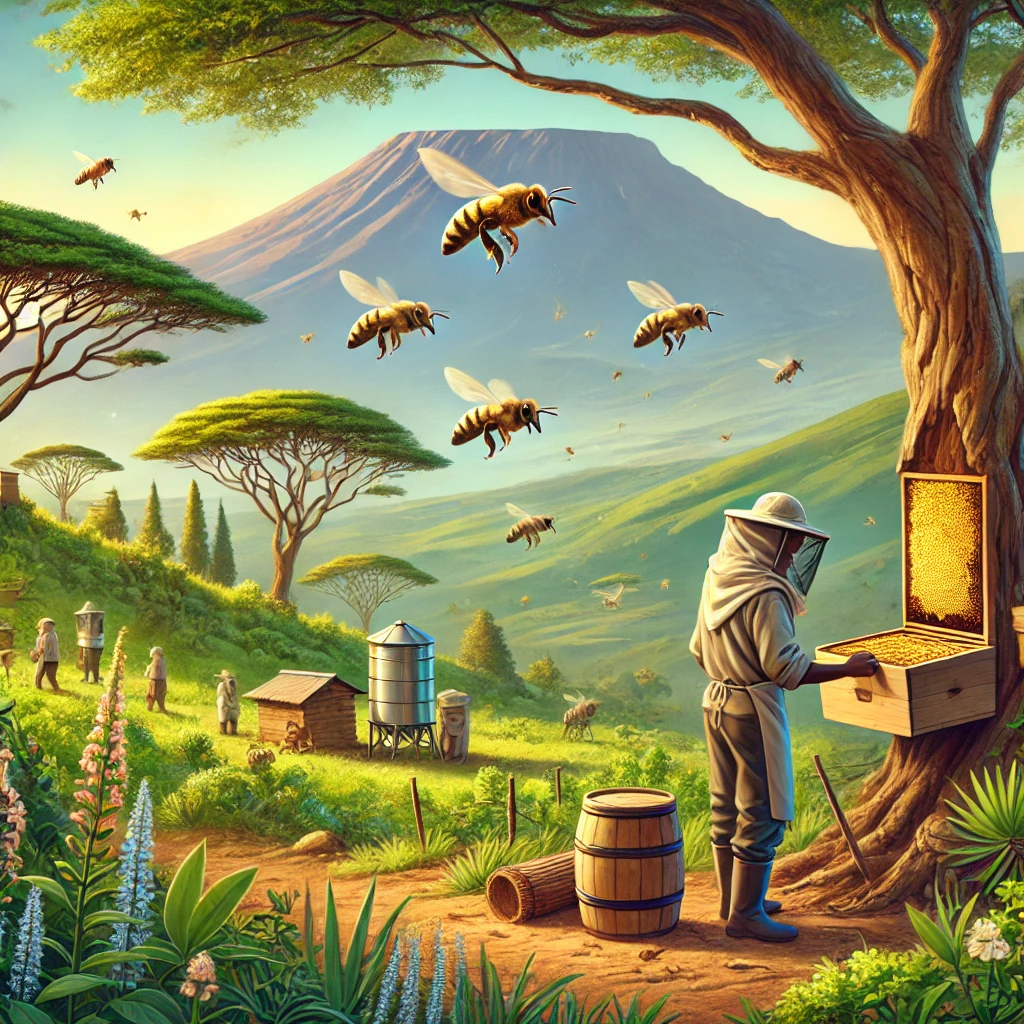
Honey harvesting in Africa has a lot of history, and the ways we’ve done it have changed through the years. Honey production in the African mountains is both a way of life and an important industry, from traditional practices to modern trends. Let’s look at the different types of indigenous African bee species, traditional beekeeping methods, and modern production techniques shaping the future of this wonderful resource.
Bees native to Africa (Apis mellifera monticola)
The African montane honey bee (Apis mellifera monticola) is the most common bee found in the African highlands. It is so well adapted to the harsh conditions of high altitude sustainability and honey with unique flavors and with medicinal properties. The montane honey bee is hardy and more resistant to diseases, so even under harsh climatic challenges such as those found in Africa’s mountainous regions, it is the ideal variety.
Beekeeping Methods: Traditional and Sustainable
Beekeeping is a family tradition passed down through generations in Africa. These approaches are simple, sustainable, and grounded in a profound respect for nature and bees. Here’s a breakdown of traditional beekeeping practices:
Finding the Right Beekeeping Location
Beekeepers select elevated areas close to forests, wildflowers, and medicinal plants. These regions are home to a multitude of nectar sources, creating honey rich in flavor and health benefits. Usually the area is chosen for the natural flower the bees feed on there.
Secondly, creating beehives
Traditional beehives are often constructed from local materials. Beekeepers can make their beehives using hollowed-out logs, clay pots and woven baskets. With a special, hexagonal design, the hives encourage bees to build their combs easily without worry of damage from either the new home or predators.
Third, the hives should be placed in a safe space
Hives are often placed in protected spots, such as tree branches, top of cliffs, or inside the woodlands. Those spots keep bees safe from human disturbance and predators, such as hornets, while granting access to the nectar-rich flora.
Fourth, managing the beehive
Beekeepers check their hives closely and keep the bees healthy. They tend to not disturb the bees too much, inspecting the hives when needed. Bees are permitted to develop their colonies naturally and beekeepers rely on local knowledge to determine how to best care for hives.
Lastly, harvesting the honey
When the bees have created enough honey, beekeepers carefully exctract it. The old way is to smoke the hive and calm the bees down so that the honeycombs can be taken out. Local producers then manually or with simple tools extract it, maintaining all its natural characteristics.
Timeless Trends in Honey Production
With the demand for high-quality honey increasing, especially on international markets, beekeeping in Africa has begun to adopt more modern and efficient approaches. Although tradition is beloved, here are the modern steps in honey production:
For the first: Better beekeeping equipment
Today, even modern beekeepers are embracing modern equipment, including stainless steel hives, extraction machines, and protective equipment. These help honey production work more efficiently, save in human safety and contamination.
Second, some advantages in hive management methods
So now beekeepers are bringing a scientific approach to hive management. This covers regular hive inspections, pest control and disease management through organic methods. New techniques, such as queen bee rearing and hive rotation, are being employed to enhance honey production as well as bee health.
The third one is use of latest honey extractor technology
Today, mechanical honey extractors are used which mechanically extract honey from the combs. These machines spin the frames of honeycomb, releasing honey without crushing comb. This results in a higher yield of honey, and retains the structure of the comb for subsequent use.
Fourthly, honey processing and bottling
Once harvested, honey is lightly strained to separate out the odd bits of debris, like beeswax or deceased bees. Honey is processed in a modern way that allows it to keep its taste and health benefits. From there, it makes its way to consumer, often wrapped in clean and hygienic processing, with an added label of organic and fair trade certifications.
Finally, sustainable methods and green apiculture
Many modern beekeepers realize this and aim for sustainability by planting more nectar-friendly plants, using biodegradable materials, and doing little to none environmental harm. This helps guarantee honey production persists without the detrimental effect on local ecosystems or bee species.
Using a good blend of indigenous knowledge and contemporary technology, African beekeeping is gaining momentum and is producing high-quality honey to satisfy local as well as global demand. Honey production remains a model of sustainability and ethical laborales, where nature and industry coexist.
Nutrition and Health Benefits of Mountain Honey
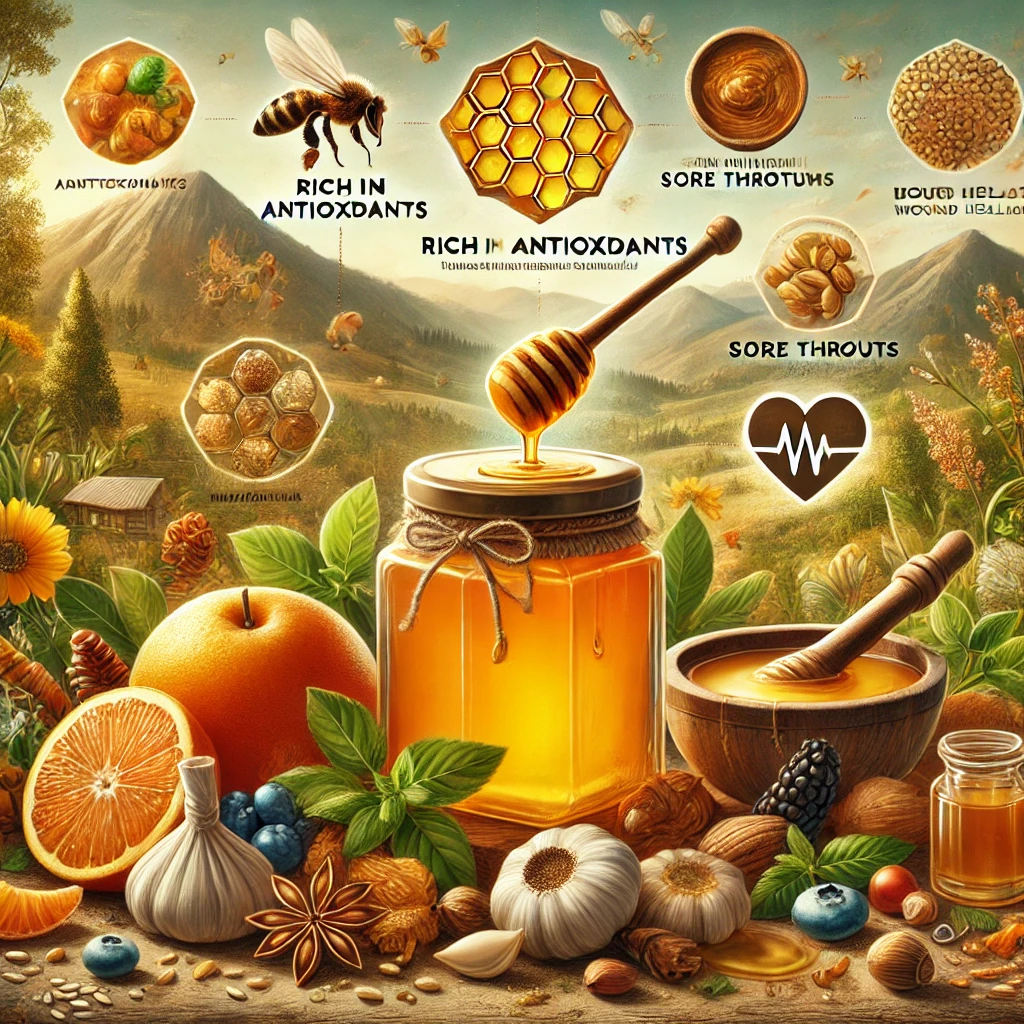
African bar honey IS GOOD FOR YOU Mountain honey is not just a sweetened food; it’s a nutritious doctor. This African mountain honey has a lot to offer whether you use it for its antioxidant properties, traditional medicine, or a natural immune booster. Here’s a closer look at its top health benefits.
High in Antioxidants & Minerals
Mountain honey has natural power when it comes to antioxidant and minerals. They also protect your body from damage by toxic free radicals that can cause cellular injury. For more: Rich mineral and antioxidants + Health benefits.
Antioxidants:
Antioxidants such as flavonoids and phenolic acids are present in honey. Other compounds work to reduce inflammation and protect your body from oxidative stress. Generally, the more dark the honey (common in mountain areas) the more antioxidants. Mountain honey contains body protecting antioxidants which promote cardiovascular health and reduces risk of chronic diseases and pathogens.
Public Opinion: Golden Mountain honey is admired by many honey enthusiasts and nutritionists for its distinct medicinal properties, which gives it comparatively higher antioxidant levels than traditional honey. People say they feel more healthy, energetic, and empowered after implementing it into their daily diets. Dark honey, found in mountainous areas, also shows higher antioxidant properties than its lighter counterparts, studies show*
It is also full of essential minerals such as potassium, calcium, magnesium and iron. These include minerals that contribute to healthy bones, muscle function, and blood circulation. Magnesium is one, which supports heart health, and potassium, which regulates blood pressure.
Health-promoting: That emphasis can range from pig-headed to extremely valuable, based on what you use it for. Mountain Honey uses it to promote better hydration, improved skin tone, and overall vitality , according to multiple reviews and wellness blogs online.
Usitional Medicine
Honey has historically been used as a medicine in Africa to treat a variety of ailments. For a reason that is often called a “cure-all” because it is versatile and has healing properties.
Wound Healing:
Mountain honey has antibacterial properties that serve as an effective remedy for minor wounds and burns. Honey can be used in the treatment of various ailments and it can also help speed the healing of cuts and wounds, prevent or alleviate irritation, and protect against infection.
Wondrous Honey: Many practitioners of traditional African medicine still advocate for the use of honey as a vital part of wound treatment. Online forums focused on holistic healing frequently recommend honey for its well-documented wound-healing properties.
* Digestive Healthy is gentle on the stomach and can help alleviate digestive problems such as ulcers or acid reflux. It balances the pH in the stomach and serves as a natural laxative when needed. Honey in African traditions is usually grossed with other herbs since it helps in digestion.
Public Opinion: Many people have reported having positive results from using mountain honey for digestive problems. Social media and wellness influencers have touted honey’s ability to improve gut health and ease discomfort from bloating or indigestion.
**Cough and Sore Throat RemedyIn many African traditions, honey is considered to provide relief from sore throats and coughs. It soothes the throat, alleviates inflammation, and has natural cough suppressant properties. It’s frequently paired with ginger, lemon, or other herbs for additional benefits.
Background: Honey used for colds and sore throat is very popular among the general public, particularly in the winter months. Many people swear by honey’s efficacy for treating cough, while online health circles often recommend a mix of honey and herbal teas.
Detoxification:
Honey has also long been used as a detoxifying agent in traditional African medicine. Flushing out the body and cleansing the liver for better digestion.
Public Opinion: Honey is used widely in detox diets and health enthusiasts often claim they have more energy or feel lighter after honey detox. Honey’s proposed ability to purify the body is a popular topic on wellness blogs.
**Strengthens Immune System and Fights Infections one of the best qualities of mountain honey is the ability to boost the immune system [1] Here’s how:
Boosts Immunity:
The mountain honey has antioxidants and antimicrobial properties that boost the immune system. It fights bacteria, viruses and other pathogens, leaving the body healthier and less susceptible to disease. Especially in the winter, drinking it regularly can offer protection against colds & flu.
Public Opinion: The public increasingly believes in the healing power of honey, especially mountain honey, for enhancing the immune system. After including honey in their daily diet, many report fewer colds or illnesses.
Promotes Skin Healing:
Honey is often used in skin care products due to its healing properties, making it effective for treating acne, dry skin, and even eczema. Honey’s antibacterial properties kill bacteria on the skin’s surface, promoting healing. It also serves to condition the skin and leave it soft and smooth.
Eye Shadow: For those of us who are literally on the go, whether we’re running from one meeting to the next or trying to sneak a glance at our children on their play dates, this long-lasting, geniously placed cream eyeshadow by Laura Mercier will dry to a fine powder, leaving you with a subtle pinch of color that will last through to the evening. Full of badger fat — about which I chewed out a post here, it is often recommended specifically in homemade skincare, with at least anecdotal evidence that it can help reduce acne and improve skin texture.
Anti-Inflammatory Effects:
Chronic inflammation is associated with a number of conditions including ng arthritis as well as heart disease. Also, mountain honey contains nutrients that help to relieve joint pain, as well as other symptoms of inflammation.
Public Opinion: Many who have inflammatory conditions such as arthritis report that regular honey can relieve pain and inflammation. It’s often part of anti-inflammatory diets, with many users reporting increased mobility and comfort.
Ultimately, African mountain honey is a delicious natural sweetener which offers many health benefits, making it one of nature’s most powerful superfoods. Whether you take it for its antioxidants, in traditional healing or to strengthen your immune system, it’s all-natural solution that is valued for centuries and continues to have an important role in health and wellness.
References:
Free Radicals and Antioxidant Activity of Flavonoids in Dark Honey, Journal of Food Science and Technology
Honey From Whence? Mountain Honey and Its Polyphenolic Contents, International Bee Research Association
Debates on the Health Benefits of African Honey, Wellness and Health Blogs
Honey for Wound Healing in African Medicine, African Journal of Medicine
Honey in Digestive Health – Traditional Uses, Traditional African Herbal Practices7
Nutritional Reviews Immune-Boosting Effects of Mountain Honey.
Honey is not a new idea, and it is nothing we have to discover; it is rooted in thousands of years of human experience.
Skin Benefits of Honey for Acne and Dryness, Beauty and Wellness Sites
Health Benefits Of Honey, Journal of Nutritional Science
Mountain Honey: Cultural and Economic Impact

The benefits of African mountain honey go beyond its nutritional value. Its cultural, spiritual and economic contributions are intrinsic to the societies that gather it. Apart from being a natural product, mountain honey is tied closely to African folk tales and important in local rituals and rural economies of the country, and also opens the door for trade and export. Let’s go through them one by one.
Honey in African Folklore and Rituals
Honey is a sacred gift of nature in many African cosmologies. For centuries it has been used in many rituals, ceremonies, and cultural practices. This honey, known for its strength, has been long part of African traditions, where it is as much food as it is spiritual Presence.
Symbol of Abundance and Fertility
Honey is a symbol of fertility, prosperity, and abundance in African folklore. In multiple African tribes, honey is a gift to gods and ancestors for multiple blessings such as good harvests, healthy livestock, and well-being. In the Ethiopian Highlands, for instance, honey is one of the traditional prayers and offerings to the spirits of the land.
Rituals and Ceremonies
African wedding rituals and coming-of-age ceremonies use honey. In some cultures, it is tradition for newlywed couples to receive honey as part of a gift for good luck and blessings. In parts of Africa, for example, honey is used in initiation rites and healing ceremonies and is consumed for strength and vitality.
Cultural Significance
In Nigeria, honey is a part of folklore symbolizing the sweetness of life. There is also a belief that honey can protect the spirit and sometimes the honey is used in rituals for this purpose to drive away the evil. Similarly, honey in Ghana is thought to be a potent cleansing agent, performing its ceremonial role to detoxify spaces.
Contextual: While tourists may be more familiar with honey than the average African, many still view the product as an integral part of the African culture and take a keen interest in the events.
Honey adds value to rural economies and livelihoods
Honey is very important for the economic development of many rural African communities where beekeeping is often a tradition practiced by generations.
Small-Scale Beekeeping:
Beekeeping is among the most sustainable forms of agriculture across much of rural Africa. It gives farmers who need honey for sale and domestic consumption a source of income. Over 308,000 beekeepers in Turkey However, beekeeping is a low-cost, environmentally friendly, and resource-efficient practice that provides a sustainable source of income in rural areas.
Job Creation:
Beekeeping is not only an income source but also generates employment in rural communities. Someone has to harvest, process, package, and distribute honey — and workers are opportunistic but opportunism can only take you so far. Bees can safely live in keeping local population resident; it is also possible to maintain hives, bees life, as well as their natural habitat. This enables communities and supports socio-economic development, particularly in areas with limited access to formal employment opportunities.
Women’s Empowerment:
In many African communities, the majority of honey is harvested and sold by women. Selling honey helps women to be financially independent and contribute to the upkeep of their families. As noted by author C. Omali, “Beekeeping has helped many women in rural areas by empowering them, providing them with an easily manageable source of income, and helping improve household living standards.
Honey production also empowers women and provides a steady, independent source of income for most families in rural areas, said several community leaders and NGOs. Local beekeepers sometimes like to think this is what they do with their honey, feel proud compare with the ones who can only sell honey and economy helpers.
Trade and Export Opportunities for Honey
Africa has witnessed a justifiable expansion of the inner demand and supply of honey products due to the growing trends of the global demand for organic, sustainable and healthy products which has also lead to the trade and export of honey products.
Rising Global Demand of Organic Honey
Internationally, the consumption of honey is also a way to show health awareness when it comes to food. Among the best-known honey is from the African Mountains, which includes honey from the Ethiopian Highlands, Rwenzori and Mount Kilimanjaro, which have very rich flavors and are produced from a variety of plants by bee species. Such uniqueness makes African honey one of the high-value product in the international market.
Export Markets
In recent years, African countries like Kenya, Tanzania, and Ethiopia have become key actors in the world honey market. European Union, Middle East and North America are the major markets for African honey. As people become more aware of African mountain honey, there is increasing demand for the product, particularly in international fairs and exhibitions, where buyers are actively seeking new, premium sources of honey.
Challenges and Opportunities
Honey trade potential vs trade deficit The honey must be up to international standards with respect to quality control, certification and processing. Nonetheless, programs such as the African Honey Initiative are working standardization of production and better market strategies, allowing access to new opportunities in international trade.
Market DemandHoney from origins with exotic and diverse backgrounds is catching international consumers interest more and more. “Mele di montagna” is “mountain honey” in Italian, and users in European and American markets have gushed over the rich flavors and potential health benefits of honey from Africa’s “montagne.”
References:
Honey And Africa Original Work: African Folklore – African Cultural Studies Journal
World Bank Agriculture and Rural Development Report Impact of beekeeping on rural economies in Africa
Journal of African Traditional Medicine / The Role of Honey in African Healing Traditions
Market Access of Ethiopian Honey – ITO Report
UN Women and Sustainable Development ReportsPowered by the Champion Beekeeping program
Global Market Trends for Organic Honey – Global Honey Market Research Report
African Mountain Honey: Characteristics and Benefits
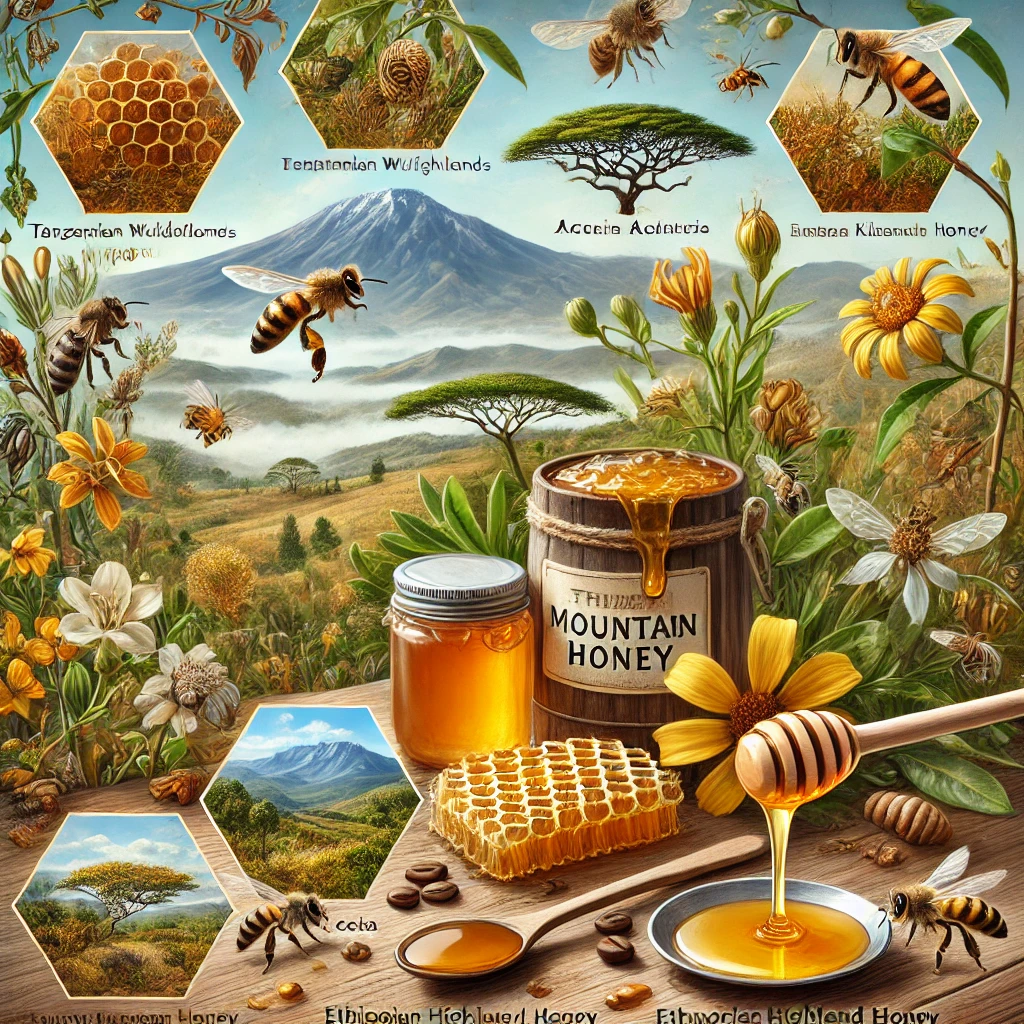
African mountain honey is characterized by regional flora, altitude and harvesting practices. A special characteristic of Africa is its vast biodiversity, and this influences the quality and unique aroma and flavour of its honeys.
Regional Flora-Inspired Flavor and Aroma Profiles
The flavor and fragrance of honey are strongly affected by the types of flowers that bees visit to collect nectar. Honey of Africa, as it is found in different area and unique flavor between local flowers.
Ethiopian Highlands Honey:
Ethiopian Highland honey: Dark, rich honey harvested from the Ethiopian Highlands. Bees forage on the nectar of coffee plants, acacia trees and wildflowers. The result is honey with a complex, slightly spicy flavor and a full-bodied aroma, often with citrus and herbal notes.
Kenyan Honey:
In Kenya, for instance, honey comes from savanna grasses, acacia trees, and eucalyptus trees. Kenyan honey has a mild, light sweetness and a subtle floral aroma. Some varieties can be herbal or woody, representing the range of plant species in the area.
Tanzanian Honey:
Tanzania produces particularly smooth, delicate honey from the Kilimanjaro region. The bees harvest nectar from plants such as mango, avocado and wildflowers, which gives the honey a mild floral flavor with hints of fruitiness and mint.
Rwenzori Mountain Honey:
Honey from the Rwenzori mountains of Uganda has a medium-bodied flavor with herbaceous elements and a slight tang. The local bees collect nectar from wildflowers, forest trees and coffee plants, lending a blend of earthy and floral tones.
Elements that Influence Quality (Purity, Elevation, and Picking Procedures)
The African Mountain Honey is though, determined by some key factors. All these factors determine the taste and aroma and has some impact on its health benefits and marketability.
Purity:
The honey purity is the trace of the natural state of honey, without many disturbances in the production models. Natural honey is unprocessed and does not include additives or artificial flavorings. Wildcrafted honey from Africa is exceptionally valued for its pure quality, an area of the world where traditional beekeepers often use traditional organic efforts. Purity also helps the honey preserve its natural enzymes, antioxidants and minerals.
Altitude:
Altitude is a vital aspect of honey production that shapes its qualities. Honey made at a greater altitude — think Kilimanjaro and the Ethiopian Highlands — tends to have a bolder, more intense flavor, thanks to the unique conditions and flora that exist at these elevations. Being that cooler temperatures and a slower process of honey development can also lead to more layers of aroma and flavor to this honey.
Why is high altitude honey so popularHighly Antioxidant: Honey collected from high altitudes is thicker and does contain higher levels of antioxidant which makes it a hot favourite among people for both cooking and health purposes.
Harvesting Practices:
How honey is harvested also affects the quality. In most parts of Africa, honey is harvested using indigenous, sustainable methods that respect the integrity of the bee colonies. The hives being handled this way ensures the honey is harvested at its prime and without contamination. Some African beekeepers, for example, use smoking techniques to calm the bees before collecting the honeycomb, making the process as seamless as possible for the bees and their ecosystem.
This Is Like The Wood Hives Are Carved Out Of A Tree — Sustainable Practices — I Wood Too; I Would Too: Sustainable practices, such as only harvesting box or cut honeys, protect honey integrity and have minimal impact on the local ecology. This is crucial for keeping honey free of contaminants and for keeping the bee populations healthy.
Processing and Storage:
Honey can be harvested in two type after which it comes in different form, but the quality remains as organic. The honey is commonly cold-pressed and gently filtered to retain its nutrients and taste. Proper storage is also necessary; honey may draw in moisture, which can ferment it and promote spoilage. Traditionally, honey is kept in sealed vessels and stored in a cool place to protect it from impurities.
Conclusion
African mountain honey has a special flavor, aroma and general quality which is associated very closely with the environment helping in its production. A blend of regional fresh flora, elevation, and sustainability in harvesting makes African mountain honey special and one of the best honeys in the world. More people globally are getting to know its unique flavor and health benefits, which means demand for this extraordinary honey is likely to keep climbing. Grasping these characteristics gives consumers a sense of the natural conditions and meticulous work that forge a honey of such quality.
References:
Flavour profiles of honey – International Journal of Bee Research and Apiculture
Altitude and Honey Quality – Environmental Science & Technology
Honey Purity and Sustainable Production — Sustainable Agriculture and Beekeeping Report
African Beekeeping Practices and Honey HarvestingAfrican Beekeeping Practices and Honey HarvestingJournal of Traditional Agriculture and Beekeeping
Ethiopian Highlands Honey and its Unique Characteristics — Ethiopian Agricultural Studies Journal
Diversity of Honey & Flora in Tanzania – Tanzanian Journal of Agricultural Economics
Mountain Honey and Challenges (African Mountain Honey: conservation efforts)
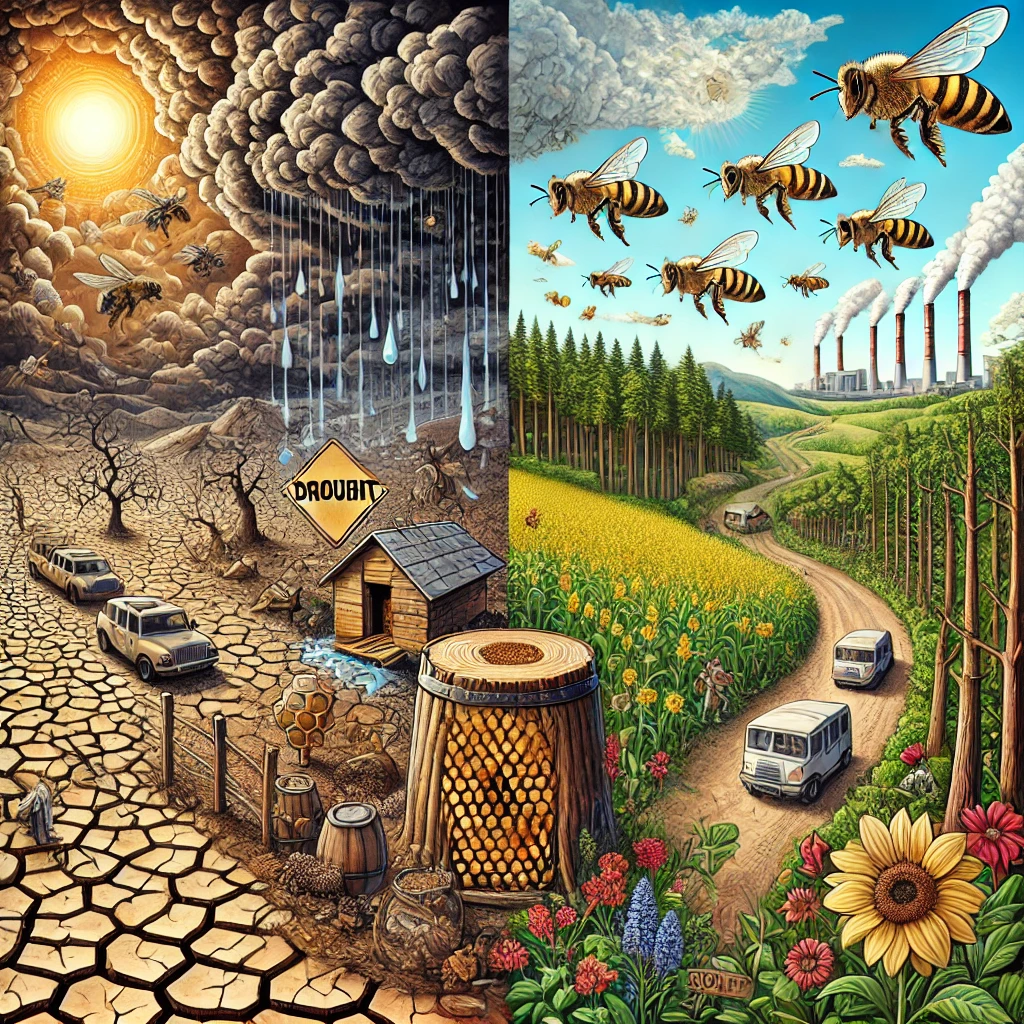
African mountain honey has earned popularity and benefits, but the producer of this special honey is facing challenges. These challenges not only threaten honey production, but also endanger bees and the larger ecosystem. Nevertheless, various initiatives are being undertaken to address these challenges and assure the sustainable future of honey production in Africa.
Threats to Honey Production
Climate Change: Climate change has affected agriculture and beekeeping in many places on Earth, and African mountain honey isn’t immune. Increased temperatures, erratic rainfall patterns and extreme weather events have had multiple adverse impacts on honey production:
It Aggregates The Destruction Of Floral Diversity: When plants change their growth cycles due to temperature and precipitation shifts, the flowers that bees depend on for their nectar will bloom too late or too early. As the concentrated biodiversity is also affected, the variety of nectar-bearing plants diminishes, which, in turn, negatively influences the quality and quantity of honey.
Flowering Patterns: Because of climate change, flowering seasons can be changed. This leads to the plants that bees usually forage may flower soon than they normally do, or flower later than they should thus interrupting bees’ ability to collect nectar and distorting honey production cycles.
Water Scarcity: In some areas in Africa, particularly in the Horn of Africa or areas of Southern Africa, droughts becomes more frequent and water scarcity leads to shortages of water for both the bees and the plants. A shortage of water can stress bees and hinder their production of honey.
Deforestation: Another serious threat to honey production in mountain regions in Africa. Destruction of forests causes:
Loss of Habitat: Bees need healthy diverse eco-systems to flourish. Deforestation, such as the Ethiopian Highlands or the area around Kilimanjaro, makes natural habitats unavailable, which disrupts nesting patterns and foraging by bees.
Decline of Biodiversity: Forests are destroyed for agriculture, development and logging, which means there are fewer types of plants that bees need for nectar to thrive. As a result, there is a shortage of diverse pollen sources, which has repercussions for the flavour and nutritional quality of the honey.
Declining Bee Populations: Several factors have contributed to the international decline in bee populations, and they have affected African honey production as well. Reasons for this decline include:
Bee population groups and others in the food chain, where chemical pesticides are used in agriculture, are poisonous or painful. Honeybees that are exposed to pesticides tend to have difficulty returning to their hives and this causes their hives become weak.
Monoculture Farming: Monoculture farming (a single crop) on large premises decreases the variety of nectar and pollen that bees have access to, and thus decreases nutrition and overall vitality. It also leaves bee populations more susceptible to disease and pests.
Parasites and Disease: Bees are also threatened by different parasites and diseases that weaken colonies, such as the Varroa mite, which feeds on honeybees and has previously caused immense bee population loss internationally.
Bees and habitat conservation projects
In Africa, there have been several initiatives aimed at protecting bees and their habitats despite this daunting challenge. Such initiatives include ecosystem restoration initiatives, improved beekeeping practices, and a sustainable future for honey production. Here are a few of these efforts:
Training of Bee Habits: There are a number of organizations in Africa that are concerned with protecting and replenishing the habitat of bees. These projects tend to look at:
Planting native trees and plants so that bees have a constant source of nectar and pollen (known as reforestation). In Uganda, Kenya, and Ethiopia, it is working to replant forests and protected areas to reintegrate the natural environment of bees.
Agroforestry: Farmers are encouraged to combine beekeeping with agroforestry systems, where they grow multiple trees and crops that enhance agricultural output as well as generate positive health effects for bees. That includes planting fruit trees, wildflowers and acacia trees, which are food sources for bees throughout the year.
Most the conservation programs in Africa focus on sustainable beekeeping practices, to foster honey production without endangering the bees or environment:
Local Beekeeper Training: Educating local beekeepers on sustainable hive management practices to avoid over-harvesting of honey It includes traditional eco-friendly beekeeping methods, as well as promoting organic honey production methods.
Natural Design Beehives: Promoting the use of natural beekeeping practices that do not use harsh chemicals or treatments which can negatively impact bee health. Local wooden hives used as part of the bee project are less harmful than modern plastic hives.
Creating Bee Hotels: In some areas, bee hotels have been made—man-made structures that serve as a nesting and shelter area for bees in places where there are limited natural resources.
Advocacy And Awareness Campaigns: One of the most critical components of conservation efforts is raising awareness about the importance of bees and the need to protect them.
Public Awareness Campaigns : When chemists began killing bees, local governments and NGOs in Africa started to educate farmers, communities, and policymakers on the importance of bees in pollination, honey production, and the environment.
School Programs and Outreach : Numerous outreach initiatives educate youth about the critical function of bees in ecosystems and food production. This involves arranging workshops and excursions to nearby beekeeping farms or natural reserves.
International Grants and Partnerships: Assistance from global organizations to support beekeeping and conservation in Africa. Donors are financing several projects, in coordination with local government, to offer resources and expertise around areas such as research, capacity building, and climate-related technologies to improve beekeeping conditions and adapt against the impacts of climate change.
References:
Journal of Environmental Science and Sustainability.
Pollinators and Bee Habitats Conservation – African Bee Conservation Organization
FAO Beekeeping Report – Sustainable Beekeeping Practices in Africa
Global Environmental Conservation: Deforestation and its effect on bee populations in Africa
Nature Conservation Research JournalDecline in Bee Populations and Its Effects on African Agriculture
International Journal of Sustainable Agriculture Agroforestry and Beekeeping for Sustainable Honey Production
Real Life Uses and Applications of African Mountain Honey
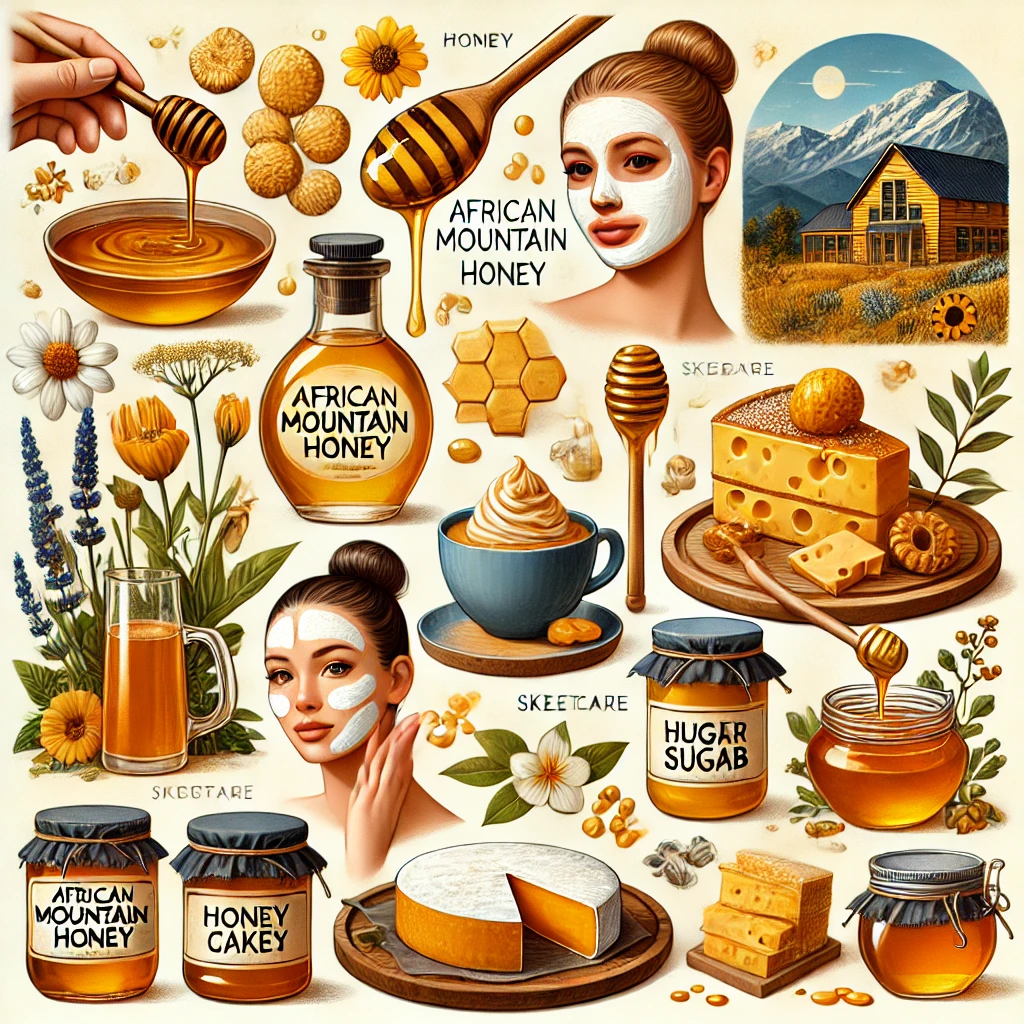
Beyond its decadent, one-of-a-kind flavor, African mountain honey is valued for its wide-ranging applications in food, skin, and preservation. Its natural properties make it a wise component in many common routines, rightly so with health benefits as well as luxury feature. Here are the areas where we can use it practically.
Culinary Applications: Pairings and Recipes
The distinct flavor profiles of African mountain honey — which can be sweet and floral or earthy and smoky — lend themselves perfectly to a number of culinary masterpieces. It enlivens both savory and sweet dishes. Here are some ways to use it:
Sweet Dishes:
Dessert Honey Drizzle: Drizzle over yogurt parfaits, fruit salads or cheesecakes for added sweetness and complexity. Its full-bodied flavor complements fruits such as mango, banana and berries.
Baked Goods: Incorporate into baking, as in honey cakes, biscuits or cookies. In addition to contributing flavor, it also helps to keep things moist once baked.
Honey and Nut Bars: Combine it with oats, seeds, and nuts to prepare your own energy bars at home, a healthy option for breakfast or munching.
Smoothies and Drinks: You could also add a spoonful of mountain honey in smoothies or to your tea, enhancing the flavor naturally. Mix it with things like ginger, lemon, or mint for extra brightness.
Savory Dishes:
Honey-Glazed Meats: Make a glaze with honey for meats, e. g. chicken, pork or lamb. Mix it with garlic, soy sauce, or mustard for a delicious marinade or sauce.
Honey in Salad Dressings: Mix honey with olive oil, vinegar and mustard to make a simple natural vinaigrette. It is great with leafy greens and fresh vegetables.
Honey on Cheese: The natural sweetness of honey is a good match for cheese, especially hard ones like cheddar, goat cheese and blue cheese. Serve it alongside a cheese board, for a pleasant juxtaposition.
Marry African flavors to honey:
Traditional dishes: Honey is a common pairing with spices such as cinnamon, cardamom, and cloves in African cuisine. It works in spicy stews, spiced rice dishes, and even as a dipping sauce for flatbreads.
Applications in Skincare and Cosmetics
African mountain honey has moisturizing, healing, and antibacterial properties, which is why it has been used as an ingredient in many skincare products. Here’s how it’s incorporated into beauty treatments:
Natural Moisturizer:
Honey is a natural humectant, which means it draws in and retains moisture. Rub it directly onto your skin to moisturize and smooth. It also serves as a face mask that hydrates dry skin, and you can use it as a lip balm to keep your lips silky.
Honey + Aloe Vera Mask: Combine honey with some aloe vera gel into a cooling face mask that can alleviate sunburns or dryness.
Exfoliation:
Honey and Sugar Scrub: Combine honey with brown sugar to make an exfoliating scrub. This diamond mixed with organic oil will removes the dead skin and helps you get soft and smooth skin.
Honey and Oatmeal Scrub: Mix honey with oats to create a gentle, natural scrub for exfoliating. It helps to exfoliate and detox the skin without being irritating.
Acne Treatment:
The antibacterial properties of honey make it a great remedy for acne. Put on a thin layer of honey to the skin and let it work for 15-20 minutes then wash off. It can help control inflammation and prevent infection.
Hair Care:
Honey and Coconut Oil Hair Mask: Blend together honey and coconut oil and use as a deep conditioning treatment for your hair. It assists in moisturizing scalp, repairing damaged hair, and facilitating healthy hair growth.
Shampoo Additive: Add a spoonful of honey to your regular shampoo to boost moisture and shine, great for dry or frizzy hair.
Soothing and Healing:
Honey is also available for wound care. It works great at healing minor cuts, burns or scratches as it has natural antibacterial properties. Just put honey on the spot, and cover it up with a band-aid.
Best practices for storage and preservation
Proper storage of your African mountain honey can keep them fresh and can prevent them from losing their quality. Here are some tips on how to best store honey:
Store in Airtight Containers:
It is preferred to store honey in glass jars for the prevention of moisture entering and to keep the honey pure. Make sure the container is airtight, so that moisture from the air doesn’t enter the honey and spoil it by fermenting it.
Honey should not be stored in plastic containers, and the container itself may leach chemicals that will affect the honey’s flavor.
Keep in a Cool, Dry Place:
Store honey in a cool, dry place away from direct sunlight. It has to be rested at a temperature of about 18–24°C (65–75°F). Honey can crystallize or lose its flavor at high temperatures.
Crystallization:
Eventually, over time, raw honey will start to crystallize, creating sugar crystals. This is perfectly normal and doesn’t affect the quality of the honey. To re-liquefy crystallized honey, submerge the jar in a bowl of warm water. Try not to heat it above 50°C (120°F), if you want to keep its enzymes and nutrients.
Do Not Contaminate the Honey:
Make sure to always use a clean spoon to scoop honey from a jar. Using dirty spoons can contaminate the honey with bacteria, and condense its shelf-life.
Shelf Life:
Because honey has natural preservative properties, it can last a long time if stored properly. But the flavor will deteriorate after a while. To enjoy its flavor and quality you should eat honey in 2 years.
References:
The biological and therapeutic effects of honey for skin wound healing: An overview – Journal of Wound Care
Honey in African Cuisine – Journal of African Culinary Arts
You can read more here Sustainable Practices in Beekeeping – World Bee Conservation Organization
Traditional and Modern Honey Use – Beekeeping Today Magazine
Honey Storage and Preservation — Food Safety Institute
Honey Purity and Quality: Guarantee of African Mountain Honey
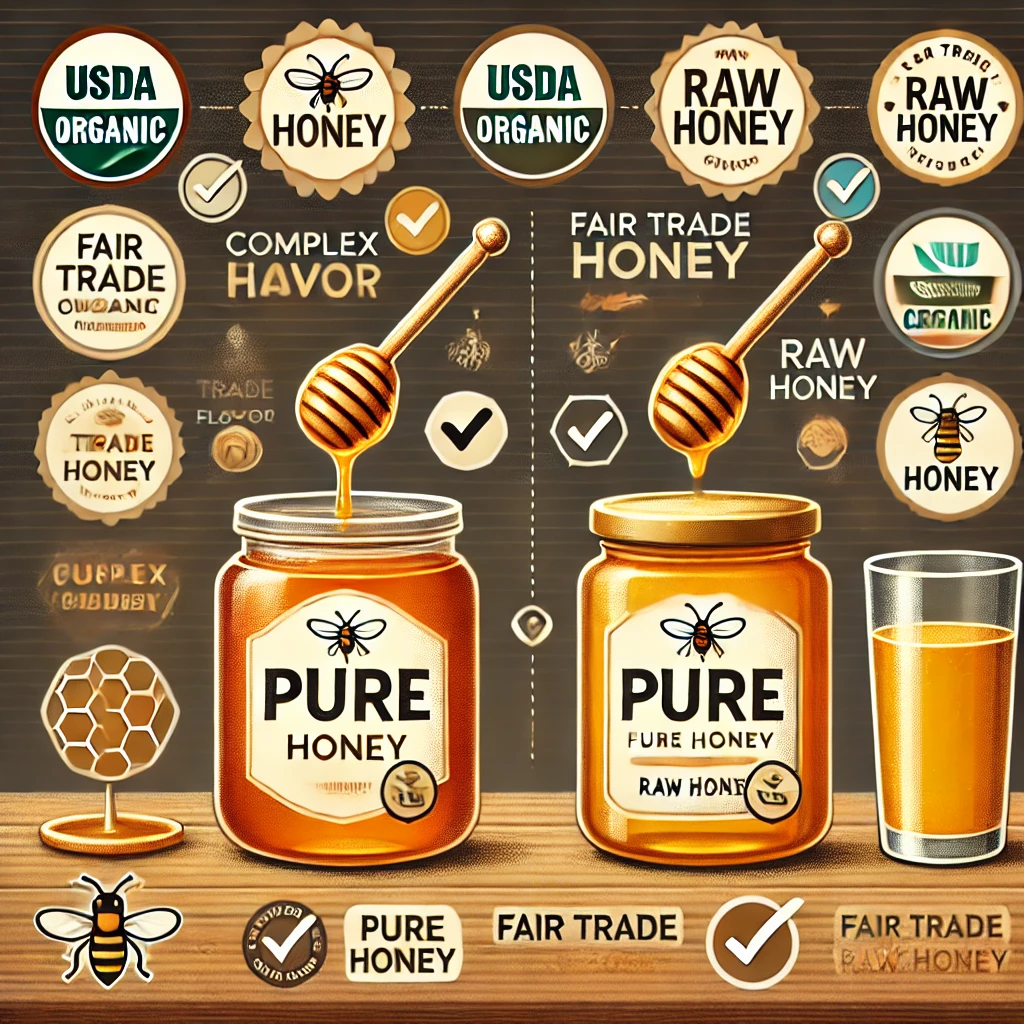
Highly prized for its distinctive flavor, natural sweetness, and health benefits, African mountain honey is a quality product sought far and wide. But as honey products become growingly popular around the world, confirming their authenticity and quality is paramount— Consumers need to know how to distinguish pure mountain honey from counterfeits in order to benefit from this special honey. Here is how to identify pure honey … and what to look for with certifications.
How to Tell Pure Mountain Honey from Counterfeit
Follow these checklists ways to guarantee the mountain honey you buy is pure and not brewed with sugars or synthetic ingredients. Here are some practical tips:
Texture and Consistency:
Pure mountain honey is always thick and viscous, but it should fall in slow drops from a spoon. Fake honey is frequently runny — watery even — as a result of added sugars or syrups.
When you stir pure honey, it sticks to the sides of a jar and doesn’t mix readily with liquids — fake honey dissolves more easily.
Crystallization:
Real honey crystallizes over time, forming fine sugar crystals. This is a natural phenomenon, especially in raw or unprocessed honey. Grainy from several floral sources, the crystallization goes from fine and smooth to coarse.
Fake or processed honey, on the other hand, can stay liquid for years because the process of pasteurization kills off the natural enzymes and alters its texture.
Taste:
Real mountain honey has a complex, flowery flavor with subtle herbal notes, according to local trees and flowers. It won’t be cloyingly sweet like the sugar syrups inside fake honey.
“Fake honey usually just tastes sweet but lacks the complexity and depth and richness from natural honey.
Smell:
The natural scent of pure honey also varies with the floral sources from which the honey is obtained. For instance, Ethiopian Highlands honey may have more of an earthy aroma, whereas Kilimanjaro honey may be more floral.
Fake honey tends to have little or no fragrance and smells synthetic because of its use of chemicals.
Water Test:
Get some water in a glass, and a little spoon of honey. Pure honey will settle at the bottom and counterfeit honey may dissolve or spread on water because it has added water or syrups.
Burn Test:
Ignite a matchstick and insert it into the honey. 100% pure honey does not catch fire because the higher sugar content does not allow burning of the honey. False honey, with extra sugars, can catch flame more readily.
What to Look for in Certifications and Labels
If you are buying honey from a supermarket or marketplace, make sure to look out for some certifications that confirm the authenticity and quality of honey. Some of the most important certifications and labels are:
Organic Certification:
Organic honey is produced by bees that pollinate flowers that are grown without the use of synthetic pesticides or fertilizers. Organic honey is often raw, too, which means it hasn’t been processed or heated to high temps, retaining beneficial enzymes and nutrients.
Organic certifications to look for are USDA Organic and EU Organic certification.
Fair Trade Certification:
By supporting this brand, we can, in turn, support farmers and producers who need fair compensation for their work. It supports better wages and working conditions for farmers and beekeepers.
Fair Trade honey (identified by a Fair Trade logo) indicates that the honey was produced under certain socially, environmentally, and economically responsible conditions.
Raw Honey Label:
Seek out “raw honey,” which means the honey has not been pasteurized or overly processed. Raw honey still contains its natural enzymes, antioxidants, and nutrients.
Supermarket honey is frequently pasteurized — heated to high temps, like milk — so that a lot of its good properties are eliminated.
Regional Certifications:
If you want to purchase African mountain honey in areas where it’s produced, check for certification that ensures it’s genuine. And both Kenya and Tanzania have certifications for honey that must pass specific quality and sustainability standards.
A few honey varieties are also certified under local geographical indications (GI), which guarantees honey is from a defined location, i.e. the Ethiopian Highlands or Kilimanjaro.
Honeys Association Certifications:
Some countries have national beekeeping associations that provide quality certifications, such as the Kenya Honey Council or the Ethiopian Beekeepers Association. The certifications guarantee compliance of the produced honey with local quality standards.
Non-GMO Label:
Non-GMO Project Verified: This label assures that the honey is free from genetically modified crops or bees exposed to GMOs. Though this label isn’t exclusive to honey, it’s a good sign for natural, clean honey.
References:
True Honey: How to Know Real Honey – Beekeeping Today
Fair Trade Certification and Ethical Honey Production — Fair Trade International
Journal of Natural Food Science
Due Organic in Honey Production – USDA Organic
Title: Geographical Indications for African Honey Publisher: World Intellectual Property Organization (WIPO)
Mountain Honey in Africa (FAQs and Quick Tips)
Here, we address the most common questions about this golden elixir, then share some quick tips for locating authentic African mountain honey.
Frequently Asked Questions (FAQs)
How Mountain Honey Differs from Regular Honey?
Mountain honey: This honey is produced at high altitudes where bees forage nectar from wild and medicinal plants. As a result, honey from hives high up in the hills has a more flavorful taste, higher mineral contents, and stronger antibacterial characteristics than honey found at lower-altitude farms.
Mountain Honey: What Are Its Health Benefits?
African mountain honey is rich in antioxidants, vitamins, and minerals. Some of its most notable advantages include:
- Immunity booster – Full of antibacterial and antifungal properties
- Supporting digestion — Good for gut bacteria and settling stomach concerns.
- Healing wounds — Used in traditional medicine due to its antimicrobial properties.
- Natural energy – Glucose and Fructose for sustained energy.
Does African Mountain Honey Qualify as Organic?
Yes, mostly mountain honey from Africa is naturally organic. The oil has very little contact with pesticides and chemicals as it is sourced from wild and remote areas. But to ensure authenticity, seek out certifications like organic, fair trade, and raw honey labels.
Is Mountain Honey Good for Skin?
Absolutely! Mountain honey is also a natural humectant, so it draws and locks in moisture. It’s used in face masks, lip balms and moisturizers to:
- Hydrate and nourish skin
- Treat acne and blemishes
- Soothe burns and wounds
How to Cook With Mountain Honey: How to Use Mountain Honey in Cooking
There are many different ways to use mountain honey:
- As natural sweetener – Use it in place of sugar in tea, coffee, desserts.
- In salad dressings — Combine with olive oil, lemon juice and mustard.
- For marinating meats — Enhances depth of flavor in grilled recipes.
- In baking – Use in breads, muffins, and pastries for natural sweetness.
How Do I Know If I Have True Mountain Honey?
To ensure you are buying real mountain honey, check for these signs:
- Thickness and texture – Pure honey is thick and it does not flow easily
- Aroma and taste – Extremely floral with a hint of smokiness.
- Raw and unprocessed —doge the hyper clear honey, as it’s likely filtered and processed.

